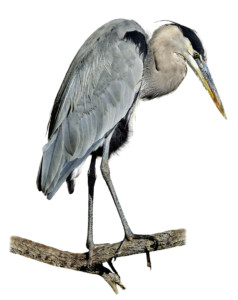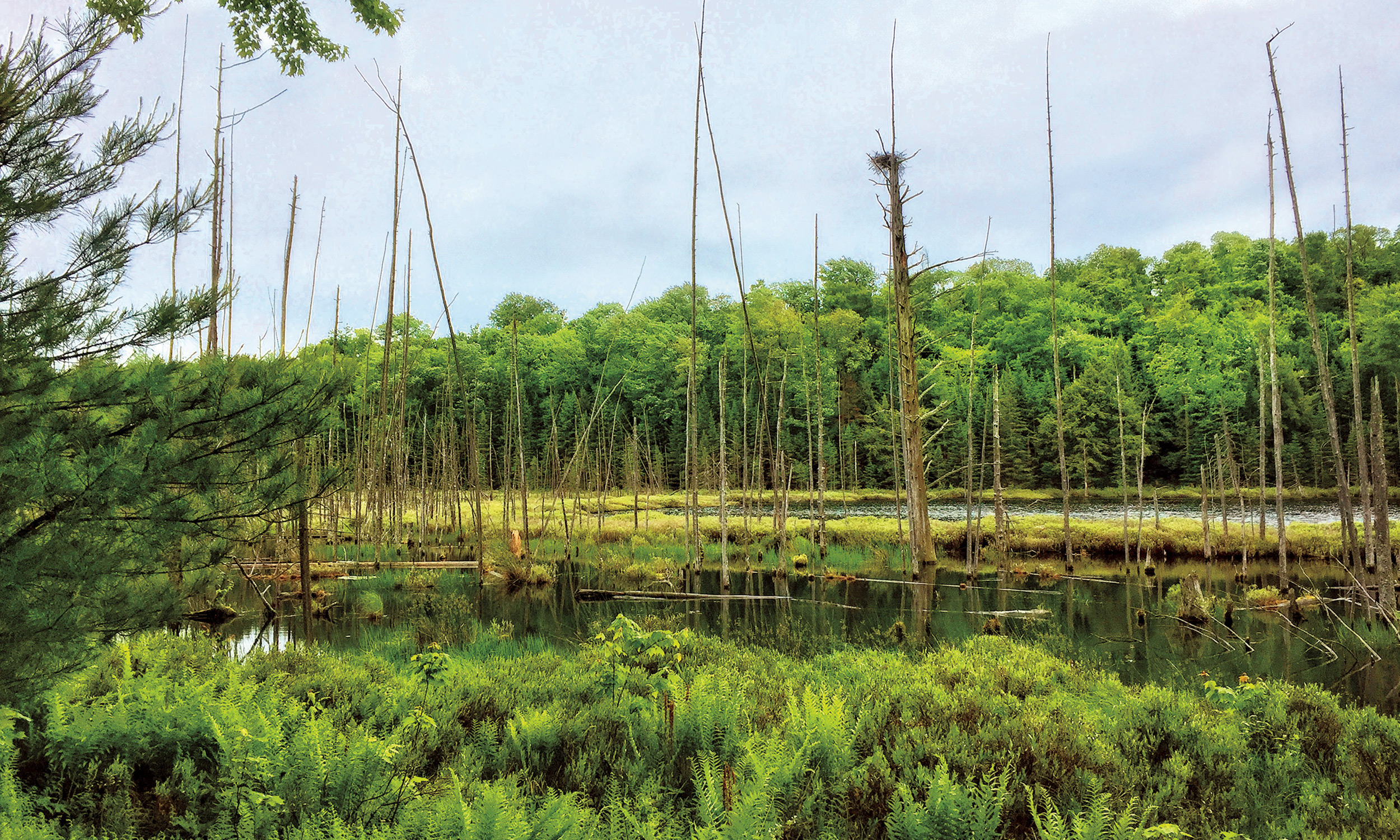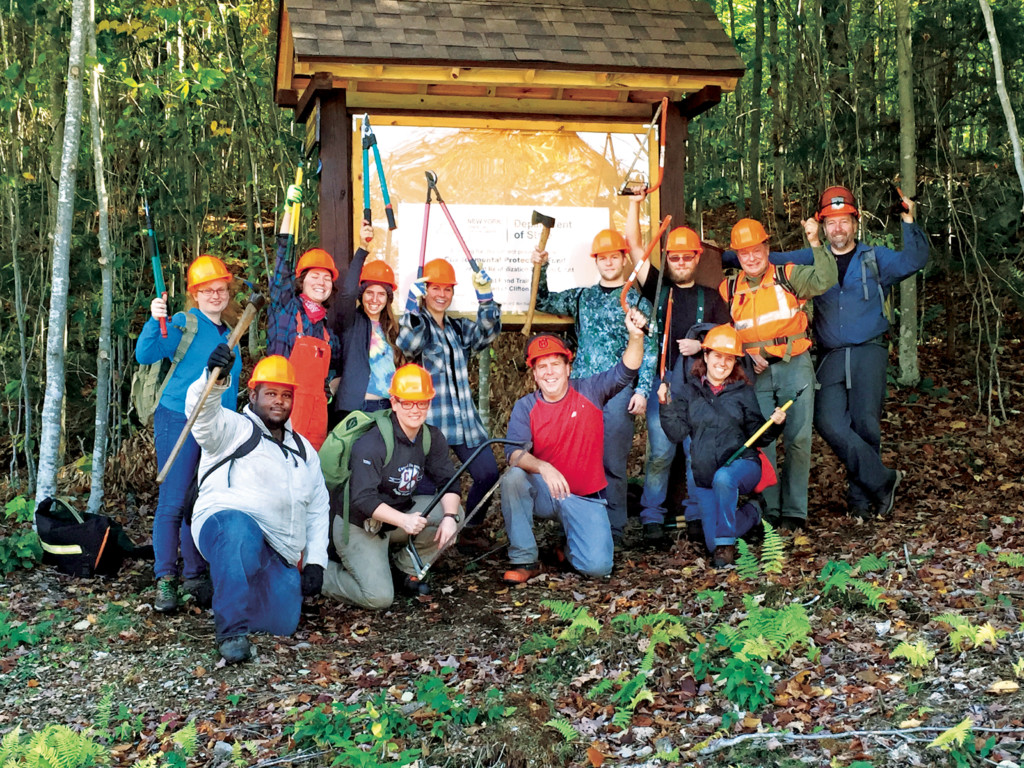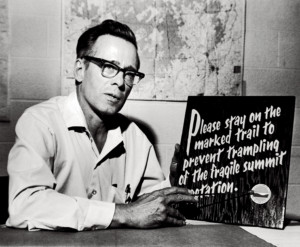The creation of a nature trail in the forest near Cranberry Lake has given ESF students from the main campus and The Ranger School a chance to retrace the footsteps of a famed ESF professor and help reinvigorate one of his pet projects.
The work is the construction of a nature trail to — and around — Lost Pond, a scenic pond fringed by a bog and marked by a great blue heron rookery, a beaver lodge and an array of wildflowers, amphibians and songbirds. To a large extent, the trail follows the same route as one walked some
40 years ago by Dr. Edwin H. “Ketch” Ketchledge, who taught at the college from 1955 to 1985. Ketchledge was a professor of forest botany and for nine years served as director of ESF’s Cranberry Lake Biological Station. He died in 2010.
In the 1970s, Ketchledge created a nature trail that ran from the state boat launch on Cranberry Lake to Lost Pond, about three-quarters of a mile away. He produced an interpretive booklet that focused on the trees and plants along the trail and the impacts of human settlement in the Cranberry Lake region. For reasons lost to history, the trail fell out of use and eventually was overgrown to the point of disappearing.
Several years ago, discussions about revitalizing the trail and extending it to loop around the pond reached representatives of the Adirondack Park Agency, including two of Ketchledge’s former students, Dan Spada ’82, M.S. ’85, and Ray Curran ’71, M.S. ’74. Curran had somehow come into possession of an original copy of his mentor’s booklet. Spada and Curran took the old guide out to the site to see
if it still had value.
“Amazingly enough, we found that a lot of the things he talked about in the field, we could still find. We saw the same plant varieties, the same cliff communities,” Spada said. “Even subtle successional dynamics were observed. For example, at Stop #1 the beech seedlings Ketch described as covering the forest floor were grown into trees.
“Ed Ketchledge, in his inimitable way, and through his eyes, was describing what we were now seeing 40 years later at that spot. He was an incredible naturalist, so he didn’t only see the plant — he talked about the geology and the climate and past forest history. It was the whole deal.”
Curran said Ketchledge had a gift for weaving together the natural world and the evolution of the landscape as affected by human impact. “A big part of it was how he reflected on the landscape. Now, there’s the old story as Ketch told it and a new story because the land around the pond has been logged since Ketch was there.”
 Eventually, with involvement by the Adirondack Park Agency; the Molpus Woodlands Group, which owns the land; the state Department of Environmental Conservation, which manages a public easement on the land; and the towns of Clifton and Fine, the project was adopted by the Five Ponds Partners, an all-volunteer subcommittee of the Clifton-Fine Economic Development Corp. Ranger School Professor Jamie Savage is chair of the partnership, which recently developed a 50-mile trail around Cranberry Lake.
Eventually, with involvement by the Adirondack Park Agency; the Molpus Woodlands Group, which owns the land; the state Department of Environmental Conservation, which manages a public easement on the land; and the towns of Clifton and Fine, the project was adopted by the Five Ponds Partners, an all-volunteer subcommittee of the Clifton-Fine Economic Development Corp. Ranger School Professor Jamie Savage is chair of the partnership, which recently developed a 50-mile trail around Cranberry Lake.
“We had the idea of a short, family-friendly trail that would be easy to get to,” Savage said. “The Five Ponds Partners became the official steward of the Lost Pond Nature Trail so we could build and maintain it.” Savage, with some volunteer Ranger School students, faculty members and community members, hiked into the woods last fall to begin clearing a path for the trail. “We started cutting out brush and some trees with hand tools, following flagging that DEC officials and I had laid out last year,” Savage said. “Then we went back this spring — on National Trails Day — with seven students from the summer forestry program and their teaching assistant, a few recent Ranger School grads who are working in the area and some local residents. We completely cut out the trail, which now goes to the pond, all the way around it and back to the parking lot.”
The 2-mile trail starts off Columbian Road, just west of the hamlet of Cranberry Lake. It takes hikers through an upland hardwood forest, along the bottom of a cliff that towers about 60 feet above the trail, and then through the mixed conifer and hardwood forests that ring the pond. The trailhead is close enough to Route 3 to attract local residents and visitors alike, but the pond itself is well buffered from the sights and sounds of the highway.
Savage will head back to the trail again in the fall with willing Ranger School students and fellow Five Ponds Partners to finish trail construction. By next spring, Savage plans to install a self-guided interpretive program along the trail, with assistance from students in his Interpretive Techniques class. “It’s important to maintain an ESF connection to this trail,” Savage said, “in honor of Dr. Ketchledge and ESF’s long-standing ties to this region.”
“It’s very fulfilling and rewarding to see this happen and to continue Ed Ketchledge’s legacy,” Curran said. “It’s great that this trail has a life of its own.”




